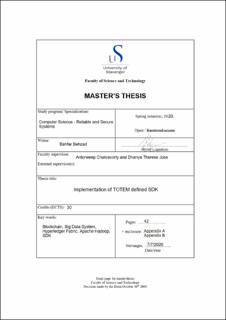| dc.description.abstract | Blockchain Technology made its first debut when Satoshi Nakamoto, whose real identity is still unknown, released the white paper Bitcoin: A Peer to Peer Electronic Cash System in 2008. This technology has developed over the last decade with the primary mission to establish a creditworthy distributed environment among various independent contributors in a non-trustable manner. The transparency, tamper-proof records, and decentralized nature of blockchain have grabbed the attention of many scientists and investors to solve old business problems in new ways.
At the same time, with Internet usage surging over the past decade, a variety of enormous data has been generated at a breakneck pace from various sources, whether it is from social media, banking sectors, governments, etc. As a result, many organizations throughout the globe have changed their work culture and adopted Big Data analytics to gain various benefits from the data being produced. Nevertheless, handling these big data was always a tremendous challenge for scientists and engineers as it involved large and complex information, which cannot be handled by conventional tools.
TOTEM: Token for controlled computation, accounts for a new concept that integrates both blockchain technologies and big data systems and uses their advantages to present a better, safer, and more cost-effective solution for both data consumers and providers. The TOTEM project's main objective is to overcome the security and privacy breaches and prevent moving large data sets across the network for analysis.
Within the TOTEM computational system, TOTEM SDK is of importance as data consumers use it to create a MapReduce code for computation, which will be performed in the data provider's environment. Depending on consumers' computational needs, pre-defined totems will be assigned to these authorized users. The SDK, along with a smart contract, forms a monitoring system that keeps track of totem value associated with users' submitted codes using an estimator table to allow codes for execution. That is how the TOTEM system puts constraints on computational operations.
This thesis will focus on specific aspects of the TOTEM project, looking into how the SDK interacts with the input data and the other components, takes the code and analyzes it within its layers, and finally, how responds to it. With SDK as the gate to connect the data consumer to the owner of data, it ensures the accountability and transparency of the results based on the rules and language defined for it. How is the SDK developed and implemented? What is the architecture used in it? These are the questions that the present study will look into in further detail. | en_US |
